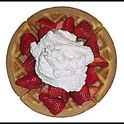Can anyone tell me what milk does - I mean, actually DOES, and whether the fat content is what matters, scientifically speaking, when making cake?
I love to bake, but my son is allergic to milk - so I've been fooling around with substitues like almond milk and coconut milk. If I can understand the science behind it, I think I'll be able to work up some better substitues!
4 Comments
The M.May 10, 2013
A good source of information on this is Paula Figoni’s How Baking Works: Exploring the Fundamentals of Baking Science. She devotes a whole chapter to dairy’s role in baking. By looking at milk’s components and what they are responsible for, you should obtain a good understanding of which substitutes to use for whichever effect you are trying to achieve. For example, soy lecithin is easily found at health-food stores and can be substituted for milk lecithin, which contributes to a more even crumb.
On page 358, Fioni lists the percentages of milk’s components (lactose, protein, milk fat, ash, and water). And on page 365, under “Functions of Milk and Milk Products,” she lists each component’s function and summarizes what they are attributed to.
Here’s a brief summary:
Increasing crust color—sugars
Delaying staling—sugars, fats
Increasing crust softness—sugars, fats
Blending flavors and providing richness in flavor—fats
Providing a fine, even crumb to baked goods—proteins, emulsifiers (lecithin), calcium salts
Forming a stable foam—proteins, fats
Aiding in the creaming of shortening—emulsifiers, proteins
Absorbing moisture—proteins, sugars
Aiding in the coagulation of egg proteins—proteins, calcium salts
Providing moisture—water
Adding nutritional value—proteins, vitamins, minerals
Figoni recommends soy milk or silken tofu as dairy substitutes. For cakes, you may look to a mixture of soy milk and vegetable oil as a substitute.
On page 358, Fioni lists the percentages of milk’s components (lactose, protein, milk fat, ash, and water). And on page 365, under “Functions of Milk and Milk Products,” she lists each component’s function and summarizes what they are attributed to.
Here’s a brief summary:
Increasing crust color—sugars
Delaying staling—sugars, fats
Increasing crust softness—sugars, fats
Blending flavors and providing richness in flavor—fats
Providing a fine, even crumb to baked goods—proteins, emulsifiers (lecithin), calcium salts
Forming a stable foam—proteins, fats
Aiding in the creaming of shortening—emulsifiers, proteins
Absorbing moisture—proteins, sugars
Aiding in the coagulation of egg proteins—proteins, calcium salts
Providing moisture—water
Adding nutritional value—proteins, vitamins, minerals
Figoni recommends soy milk or silken tofu as dairy substitutes. For cakes, you may look to a mixture of soy milk and vegetable oil as a substitute.
ChefOnoMay 10, 2013
With respect to cakes (including pancakes and waffles), milk's fat and protein are relatively minor players. Milk affects flavor directly and, perhaps most importantly, indirectly through caramelization (browning) of the lactose. It also strengthens gluten and thus affects rise and strength. You might want to consider subbing goat milk.
SaerMay 9, 2013
Thanks! This is such helpful information - and explains why the almond milk I used in some cornbread early this week was, as you said, utterly flat! I have found that coconut milk (as in, canned coconut milk) works quite well in pancakes, but that's about it.
HilarybeeMay 6, 2013
In a cake recipe, milk is acting as a liquid, and contributing a modest amount of fat to a recipe. Milk also contains lactose sugar and protein; so it is somewhat multi-functional ingredient.
I've done a lot of vegan baking for my farmer's market stand, and I usually don't use almond milk or coconut. They create a really delicate end product--that I've found to be somewhat dry and disintegrates quickly. Texturally, I usually like to use unsweetened soy milk and safflower oil. For a neutral taste, I use unsweetened rice milk. You may be able to employ fruit or vegetable puree to help get the right substitutes- I like pumpkin, applesauce and avocado or beets for chocolate cake.
I would really recommend reading up on vegan baking. There are some really great recipes out there, so there really isn't a need to make up your own at first. Try some of these vegan standards, and then adjust them to your needs.
Two excellent sites (1) Vegan Baking net and (2) Post Punk Kitchen http://www.veganbaking.net/
http://www.theppk.com/
I've done a lot of vegan baking for my farmer's market stand, and I usually don't use almond milk or coconut. They create a really delicate end product--that I've found to be somewhat dry and disintegrates quickly. Texturally, I usually like to use unsweetened soy milk and safflower oil. For a neutral taste, I use unsweetened rice milk. You may be able to employ fruit or vegetable puree to help get the right substitutes- I like pumpkin, applesauce and avocado or beets for chocolate cake.
I would really recommend reading up on vegan baking. There are some really great recipes out there, so there really isn't a need to make up your own at first. Try some of these vegan standards, and then adjust them to your needs.
Two excellent sites (1) Vegan Baking net and (2) Post Punk Kitchen http://www.veganbaking.net/
http://www.theppk.com/
Showing 4 out of 4 Comments
Recommended by Food52
Popular on Food52
Continue After Advertisement

